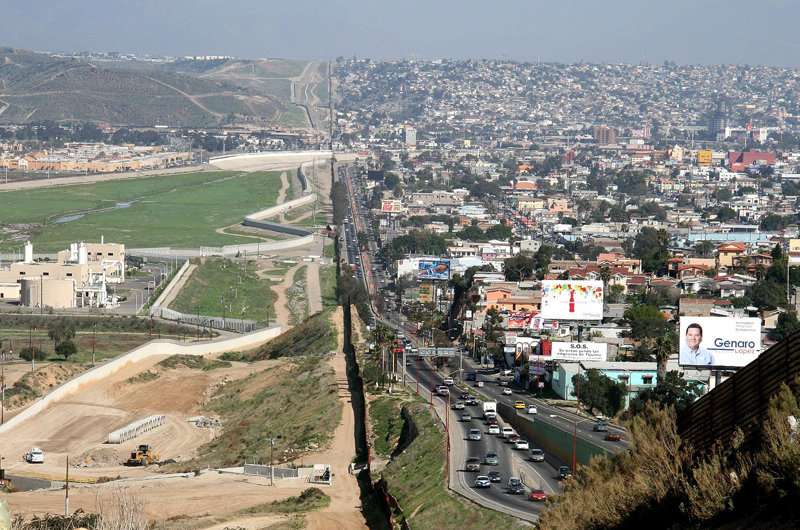Mexican migrant health access lower after U.S. border crossing—and even when they return to Mexico

Health care access nosedives for Mexican immigrants and migrants once they cross into the United States—and stays that way even if they return to Mexico—a Drexel University public health study found.
The study, published in the Journal of Health Care for the Poor and Underserved and led by Ana Martinez-Donate, PhD, associate professor in Drexel's Dornsife School of Public Health, looked into how mobility affects the ability of people to get health insurance and access health care.
And while roughly 84 percent of Mexican immigrants and migrants were found to have health insurance before they crossed the border, that number fell into the 25 to 50 percent range afterward, the study showed.
Moreover, the ability to get healthcare dropped from 78 percent of all Mexican adults to between 47 and 60 percent once the immigrants/migrants crossed the border.
"Once in the U.S., migrants may have less access than they did in Mexico before they left their communities of origin," explained Martinez-Donate. "And then, after they migrate to the U.S., even when they are back temporarily in Mexico, they may experience barriers to health care access there because they are not covered by the Mexican insurance programs either."
The study used data on more than 1,500 people from a survey of migrant flows conducted in Tijuana, Mexico, a popular border crossing point (between 30 and 40 percent of immigrants and migrants traveled through the city). To get a sense of how the data related to moving in and out of the United States, the researchers broke the data down into different phases to measure health care access in Mexico before they left, what it was like in the United States, and how it was in Mexico once they returned.
"Aspects of health care systems on both sides of the border, such as employer-based health care and minimum-stay requirements for insurance make it difficult for mobile populations to get health care," said Félice Lê-Scherban, PhD, assistant professor in the Dornsife School of Public Health who served as a co-author on the study.
Current estimates place the undocumented immigrant population in the United States at 12 million. Much of this population is believed to be young and healthy (as they are largely mobile laborers). And while there is some truth in that notion, the researchers believe that this view of the healthy immigrant/migrant might mask some serious health concerns experienced by a portion of this population.
"Traditionally, we have seen higher rates of occupational injuries owing to the more dangerous types of occupations—like agriculture and construction—and less regulated conditions under which this population works," Martinez-Donate explained. "In our ongoing analysis, we are also seeing high rates of obesity and self-reported markers of chronic disease, such as diabetes and hypertension, along with depression, stress and at-risk drinking."
All of this can add up when you forgo regular care, which the study showed a higher rate of immigrants and migrants do. Before they left Mexico, only 6 percent reported doing that, but more than 16 percent who returned said they went without needed medical care.
Additionally, 68 percent of the immigrants/migrants reported having a usual source of care before they left Mexico, compared to just 42 percent of those who returned.
"The lack of access to care impedes effective treatment and, in the case of infectious diseases, may facilitate their transmission to others," Martinez-Donate explained. "For chronic conditions, like diabetes, the lack of treatment may result in complications and the need for more expensive treatments."
Not only were levels of care below what the immigrants and migrants could have expected to receive in Mexico, they were well below U.S. standards. Roughly 74 percent of U.S. adults get regular health care compared to the 47 to 60 percent of Mexican immigrants/migrants.
Martinez-Donate believes that some important changes in policy—both in the U.S. and Mexico—can be made to better look after a segment of the population that is critically intertwined with U.S. agriculture, construction and hospitality—and also sends home $25 billion a year to Mexico.
"Some experts have suggested the development of a portable health insurance program, Matinez-Donate said. "Other options may include expanding eligibility criteria to allow migrants, regardless of immigration status and length of residence, to qualify for the Affordable Care Act and facilitate enrollment in Seguro Popular—the Mexican insurance program for the unemployed—if they return."
More information: Ana P. Martinez-Donate et al, Access to Health Care among Mexican Migrants and Immigrants: A Comparison across Migration Phases, Journal of Health Care for the Poor and Underserved (2017). DOI: 10.1353/hpu.2017.0116

















